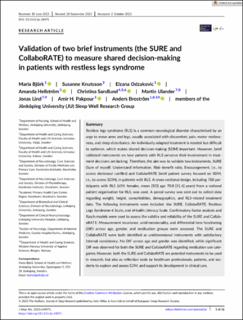| dc.description.abstract | Restless legs syndrome (RLS) is a common neurological disorder characterised by an urge to move arms and legs, usually associated with discomfort, pain, motor restlessness, and sleep disturbance. An individually adapted treatment is needed but difficult to optimise, which makes shared decision-making (SDM) important. However, brief validated instruments on how patients with RLS perceive their involvement in treatment decisions are lacking. Therefore, the aim was to validate two instruments, SURE (Sure of myself, Understand information, Risk–benefit ratio, Encouragement, i.e., to assess decisional conflict) and CollaboRATE (brief patient survey focused on SDM, i.e., to assess SDM), in patients with RLS. A cross-sectional design, including 788 participants with RLS (65% females, mean [SD] age 70.8 [11.4] years) from a national patient organisation for RLS, was used. A postal survey was sent out to collect data regarding weight, height, comorbidities, demographics, and RLS-related treatment data. The following instruments were included: the SURE, CollaboRATE, Restless Legs Syndrome-6 Scale, and eHealth Literacy Scale. Confirmatory factor analysis and Rasch models were used to assess the validity and reliability of the SURE and CollaboRATE. Measurement invariance, unidimensionality, and differential item functioning (DIF) across age, gender, and medication groups were assessed. The SURE and CollaboRATE were both identified as unidimensional instruments with satisfactory internal consistency. No DIF across age and gender was identified, while significant DIF was observed for both the SURE and CollaboRATE regarding medication use categories. However, both the SURE and CollaboRATE are potential instruments to be used in research, but also as reflection tools by healthcare professionals, patients, and students to explore and assess SDM, and support its development in clinical care. | en_US |

